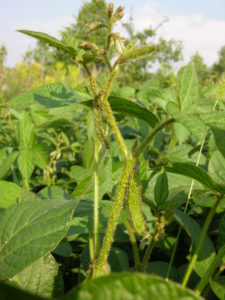With the exception of the last few hot days, these slightly cooler than norm July temps are ideal for soybean aphid development. They can double their populations in a matter of days when temperatures are moderate. There haven’t been many reports of threshold levels being found in the fields so I am a little worried that not everyone is taking the time to check their fields.
It is important to scout soybeans every 7 to 10 days until populations are found and then more frequently (every 3–4 days) as aphid populations approach the threshold. Look at 20–30 random plants across the field. Avoid field edges. Estimate the number of aphids per plant and the abundance of natural enemies present. A minimum of two field visits is required to confirm that aphid populations are increasing.

Action Threshold: The threshold for soybean aphids is 250 aphids per plant and actively increasing on 80% of the plants from the R1 up to and including the R5 stage of soybeans. This threshold gives an approximate 7–10-day lead time before the aphids would reach the economic injury level, where cost of control is equal to yield loss. When soybean aphid populations are not consistently increasing above 250 aphids per plant, natural enemies are keeping up with the aphid population. Plants with aphids accumulating along the stem and pods of the plant is usually a good indication that threshold has been reached. In good growing conditions when plants are not stressed and are lush, waiting until the aphids are closer to the economic injury level of 660 aphids per plant is possible.
The Aphid Advisor is a helpful tool to use when scouting for soybean aphids. Based on the aphid and natural enemy numbers found while scouting each field, this free app determines if there are enough natural enemies to keep aphid populations in check or if an insecticide application may be needed.
Remember that soybeans can be foraged by pollinators when in flower. Time insecticide applications to minimize bee exposure. Spraying in the evening after 8 pm when temperatures are below 13°C helps minimize honey bee exposure, unless there is evidence of a strong temperature inversion. The second best option is to spray early in the morning before 7 am. If you plan to spray, contact beekeepers who have hives within 5 km of the field so that they may take further measures to reduce risk of exposure. For more information, visit the OMAFRA Using Pesticides in Ontario “Bee Poisoning” Section.